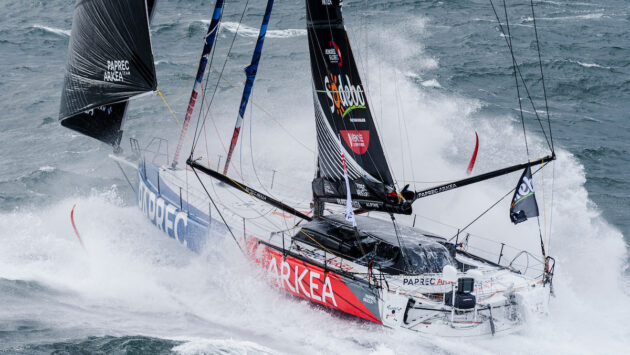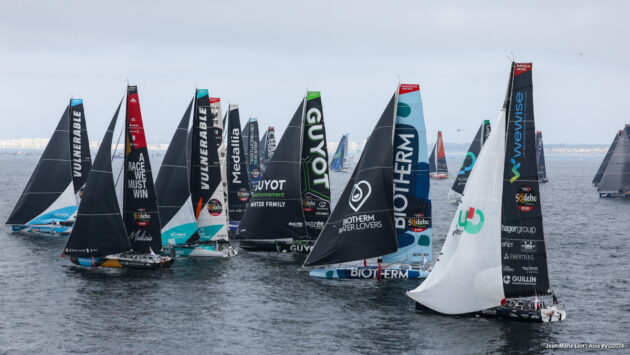The 10th running of the Vendée Globe set off today - but who will win the round the world epic? Here's our pick of the fleet from the pontoons of Les Sables d'Olonne
So who will win the 2024 Vendée Globe?
Spoiler alert: we don’t know .
And that’s not only because of the Vendée Globe’s notorious attrition rate (somewhere between 1 in 4 and 1 in 3 entries are statistically likely to fail to complete the course), but because with this year’s record entry of 40 IMOCAs and hugely competitive fleet, even the skippers struggle to work out where they rank against each other.

Eyes on the prize: Jérémie Beyou looks at the Vendée Globe trophy as he heads to the start. Photo: Anne Beaugé / Alea
How to pick the top IMOCAs
“Previously in the IMOCA class, you just had to have a reasonable boat. The fleets were so small that if you had a reasonable boat and an okay budget, then you were pretty much guaranteed to be in the top five.
“Now with that, you can just be in the top 20,” explains Sam Davies, skipper of Initiatives Coeur, ahead of this year’s start.
“It’s something we’ve worked on, because it’s really hard to know where to expect to be. Sometimes I’d finish a race and I’d feel really happy with the result, and the team would be really frustrated because we weren’t all on the same page.”

LORIENT, FRANCE – British skipper Sam Davies on Imoca Initiatives Coeur. Photo by Jean-Louis Carli/ALeA
To help them gauge performance, before every race in the lead up to the Vendée Globe, Davies and her team would create a table ranking the boats and skippers against her and her boat.
“We have an open debate between us in the team [and score each column] either +1, 0, or -1. One means the boat is better than my boat. Zero, equal. Minus one, I’m better. And we do both boat and skipper because you can have a really good boat with a less experienced skipper. Then you add the two together and that result is one, zero, or minus one.
“At the end, you have a group that is better, a group that’s equal, and then there’s a group that I should be ahead of.”
40-boat Vendée Globe fleet
The problem is that if you do that exercise for the Vendée Globe itself, even once you’ve ranked all the entries into groups, with a huge fleet of 40 boats each ‘group’ is so large and evenly matched that they’re simply too hard to split.
Recent transatlantic races have been decided by minutes, if not seconds. And that’s with some of the skippers sailing – relatively – conservatively in order to secure their Vendée Globe qualification miles.
So the best we can offer – and yes, it is a bit of a cop-out – is to group the fleet. Here’s our best guess at the likely front-runners and races-within-a-race for the 10th edition of the Vendée Globe (you can see how well we do on the live tracker):
Winning potential
Picking a winner is a fool’s errand. As Jérémie Beyou pointed out, whilst many people pegged him and Alex Thomson as among the favourites for the last race, both suffered damage which ended their chances. Meanwhile few commentators picked Yannick Bestaven as a winning bet.
Also, as Davies explained, the fastest group used to be comprised of four or five boats, but there are now double figures of boats that could be in it.
So whilst we’ve picked our top four, if any are forced to retire or have their performance limited by damage, there’s a huge group of other IMOCAs and skippers that could move up.

Charlie Dalin’s Macif is one of the favourites to win the 2024 Vendée Globe. Photo: Ronan Gladu / Disobey / Macif / VG2024
Caveats out of the way, we think the four strongest contenders for line honours are Charlie Dalin Macif, Thomas Ruyant Vulnerable, Jérénmie Beyou Charal 2, and Yoann Richomme’s Paprec Arkéa.
Of these Dalin probably has the slight edge. Not only does he have an incredibly well-prepared and optimised boat, but the added factor of having been the skipper to lead the fleet home last time around, although he ultimately finished 2nd after redress was awarded for the boats involved in Kevin Escoffier’s rescue.
Richomme might be a Vendée first timer but he knows how to perform on the big stage, having twice won La Solitaire du Figaro. Though a newcomer to the IMOCA class, he won his very first two races in the fleet with his Koch/Finot Conq design. A smart and tough sailor who’s known to push his boat hard. Which means if he doesn’t break anything, he could be right up there.

Yoann Richomme’s Paprec Arkea is a Koch/Finot Conq design. Photo: Eloi Stichelbaut – polaRYSE / Paprec Arkea / IMOCA
Ruyant has closely matched Dalin for much of the past IMOCA cycle, and the pair are still hard to split. He has a fast new Antoine Koch/Finot Conq design that’s a sistership to Richomme, won the major transatlantics in 2021/22/23, and was in the top three for much of the last Vendée until foil damage slowed him.
Jérémie Beyou is another who has a fearsome amount of experience combined with a latest generation IMOCA that is a regular on the podium. It’s hard to bet against Beyou being in the top three.
‘Top five’ challengers

Sam Goodchild is a Vendée ‘rookie’ with a lot of ocean experience. Photo: Pierre Bouras / TR Racing / IMOCA
We’d love to see an English skipper like Sam Davies or Sam Goodchild lead the Vendée Globe this time around, and they certainly have the potential, but even if not amongst the very front runners we expect them to be part of a strong group of podium or just-off-the-podium contenders.
Boris Herrmann’s Malizia-SeaExplorer has the most miles under its belt of any IMOCA, and has proven itself to be robust, reliable, and fast in the big stuff. If Herrmann can hang onto the more slippery designs in the forecast lighter early stages – and particularly if the fleet picks up some conventional strong Southern Ocean conditions – then this boat could be right up there.
Sam Davies’ Initiatives Coeur had some build teething issues, but with those ironed out Davies seems to be hitting her best form at just the right time.
Sam Goodchild is another ‘rookie’ who is actually hugely experienced, and has the particular advantage for a Vendée first-timer of having already raced in the Southern Ocean in the Class 40s, Ultims and onboard Holcim PRB in The Ocean Race. His Vulnerable is not a latest generation design, but is Ruyant’s IMOCA from last time. Working with Ruyant, the team made the decision not to make any major changes, hinting at confidence that it is still competitive.

Nico Lunven and Holcim-PRB could be strong contenders in the 2024 Vendée Globe. Photo: Adrien Nivet / Polaryse / VG2024
Nico Lunven might have a slightly lower profile than some of the solo stars of the IMOCA fleet, but he won two Figaros and has sailed with, or routed for, many top teams. His Holcim-PRB is known to be fast, and though his recent results perhaps don’t reflect it, many of the other sailors rate him highly.
Yannick Bestaven‘s new Maitre Coq V is fairly unproven, but he delivered a surprise win in the last race, having put in a solid performance with high averages, and could do the same once again.
‘Top 10’ contenders
Those of you who can count will have worked out that we’ve already picked out 9 boats, and are yet to list our ‘top 10’ grouping. But assuming that there will be at least some retirements in the race, this sector of the fleet could be incredibly closely fought. They include:
Maxime Sorel, who has a refined new boat with V&B Monbana Mayenne, and a series of top 10 results with it.

Paul Meilhat’s Biotherm was thoroughly tested during The Ocean Race. Photo: Qaptur/VG2024
Paul Meilhat also has a latest generation IMOCA with Biotherm. Although the boat seemed a bit tender during The Ocean Race, its structure has been beefed up and if average conditions are on the lighter side could prove very rapid. Another one that other skippers will be keeping a close eye on.
The top boats from the last IMOCA cycle have real potential and many have been smartly reconfigured. Sebastien Simon has the former Ocean Race winning boat (ex-11th Hour Racing). Meanwhile Justine Mettreaux was part of that winning team and can take the experience of those ocean miles onto her first Vendée with Teamwork Team SNEF (which is the former Charal).

Justine Mettreaux has a fast last generation boat with Teamwork Team SNEF (ex-Charal) and plenty of IMOCA experience in The Ocean Race. Photo: Gauthier Lebec/VG2024
Clarisse Cremer has had a disrupted campaign, but has Dalin’s ex-Apivia, which was first around the course last time, prepared with Alex Thomson’s team in Gosport. She’s proven repeatedly that she is not to be underestimated, and could definitely be in the front group with L’Occitane en Provence if it all comes together in time.
Alan Roura’s Hublot is the former Hugo Boss from the last race, and he’s made some significant modifications to it. Though he’s not going into this race with the pressure of expectation, he’s hoping to be in the top 10.
Louis Burton finished an impressive 3rd in the last race. This time he’s sailing the first ‘scow’ in the fleet, Sam Manuard’s 2019 design, having identified it as a boat which will suit his hard-pushing style as Bureau Vallée.
Pip Hare’s Medallia is the oldest boat of this group, but the 2015-built ex-Banque Populaire currently holds the course record, and has been re-optimised with a new boat shape and larger foils. Hare is gunning for a top 10 position and her results show a clear uptick with a 9th in the most recent New York-Les Sables transat.

Pip Hare’s re-optimised Medallia is the current Vendée Globe course record holder. Photo: James Tomlinson
Another 20 boats to go…
That’s less than half the fleet, and we haven’t even touched on Damien Seguin, who finished an impressive 7th last time around, followed by Giancarlo Pedote and Benjamin Dutreux, who are also returning.
Or newcomers like Guirec Soudee, who has years of adventure sailing experience (most famously with his red hen Monique) despite being aged just 31, and will be likely able to handle any damage or crazy conditions this race throws at him.
Then there’s the ‘daggerboard’ fleet – which could be a race within a race. Or, if legendary skipper Jean Le Cam is correct – and the lighter winds hold into the south Atlantic– the straight board boats could mix it up with the foilers.

Jean Le Cam with his new non-foiling IMOCA Armor-Lux. Photo: Marc Agnoly/IMOCA
Le Cam is one of two skippers who opted to build a brand new non-foiling boat for this race, believing that the performance advantages simply weren’t worth it. As he’s going into his sixth Vendée Globe, that’s a lot of experience to discount. Last time around he finished 4th, in a straight board boat, having picked up the shipwrecked Kevin Escoffier mid-race.
If that proves anything, it shows that Vendée Globe form indicators are only as good as the skipper, the weather, and the many twists of fate this race inevitably deals out.
We’ll be following all the way – plus look out for our IMOCA boat tours and exclusive skipper interview videos.




